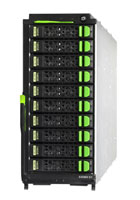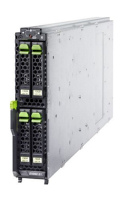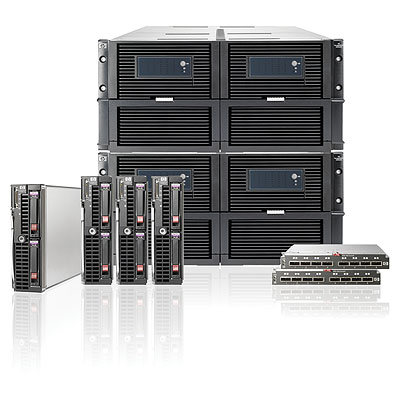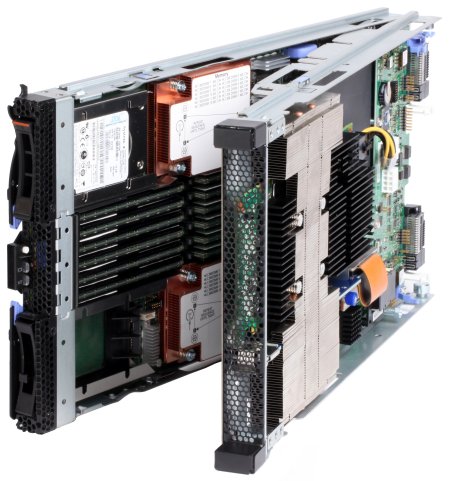IDC came out with their 3Q 2010 worldwide server market revenue report last month which shows that IBM grew from Q2 2010 in their blade market share. Continue reading
Fujitsu Teams up with NetApp to Design a Storage Blade
Continuing with my theme from yesterday of “purpose-built” blade servers, today we take a quick look at a new offering from Fujitsu. Now, as you may have noticed, my site has traditionally been focused on blade servers from Cisco, Dell, HP and IBM but this offering from Fujitsu is so interesting, I figured I would write something up. Titled under the PRIMERGY SX label, Fujitsu’s storage blades combines Data ONTAP-vTM software from NetApp, blade hardware and an unknown hypervisor to create a “fully integrated virtual storage appliance.” The storage solution supports iSCSI, CIFS and NFS protocol and is based on Data ONTAP-vTM features such as SnapShot, FlexVol, SnapRestore and FilerView.
Titled under the PRIMERGY SX label, Fujitsu’s storage blades combines Data ONTAP-vTM software from NetApp, blade hardware and an unknown hypervisor to create a “fully integrated virtual storage appliance.” The storage solution supports iSCSI, CIFS and NFS protocol and is based on Data ONTAP-vTM features such as SnapShot, FlexVol, SnapRestore and FilerView.
The storage blades come in two flavors:
PRIMERGY SX960 S1 – a storge blade that can hold up to 10 additional hot-plug SAS or SATA HDD/SSD. These drives offer high capacity with up to 5 TB SATA HDDs, 3 TB with top-quality 2.5- inch SAS drives and up to 640 GB with power-saving 2.5-inch SATA SSDs. The only catch is that you can only fit 2 of these storage blades into a single chassis.
PRIMERGY SX940 S1 -a storge blade that can hold up to 4 additional hot-plug SAS or SATA HDD/SSD. These drives offer high capacity of up to 584 GB with high quality SAS drives, up to 2 TB with SATA HDDs .
.
I understand that Fujitsu is nearly non-existent in North America, but overseas they are well-known. As well, the purpose of this post to showcase that Fujitsu is putting NetApp’s software expertise onto a blade footprint to be used as a single purpose – to create a virtual storage array. As blade servers become more more mainstream, I expect to see more vendors team up to offer these types of integrated solutions.
For more information on Fujitsu’s servers, please visit:
http://ts.fujitsu.com/products/standard_servers/blade/bx400/storageblades.html
A special thanks to Chris Mellor for his write-up on this Fujitsu offering as seen on theregister.co.uk. Сайт знакомств
groupon houston
alcohol poisoning symptoms
endometriosis symptoms
foundation grants
strep throat contagious
Another Hidden HP Secret: P4000sb Storage Blades
 I recently found another hidden gem within HP’s arsonel of offerings that combines the HP StorageWorks line with the HP Proliant BladeSystem line. The solution is found within an HP bundle titled, “HP StorageWorks P4800 G2 63TB SAS BladeSystem SAN Solution” and is quite an offering. Continue reading
I recently found another hidden gem within HP’s arsonel of offerings that combines the HP StorageWorks line with the HP Proliant BladeSystem line. The solution is found within an HP bundle titled, “HP StorageWorks P4800 G2 63TB SAS BladeSystem SAN Solution” and is quite an offering. Continue reading
Still Confused About Cisco’s Blade Market Share
I recently received a comment on my previous post concerning Cisco’s market share (“What’s the Truth About Cisco’s Market Share“) which has me more confused. The comment admits that Cisco has not released any market share data to IDC, but that when you look at the Cisco Q1 2010 Earnings Call and compare it to IDC’s findings of the overall industry you should be able to derive conclusions from there. That’s where it gets confusing. Continue reading
HP Earns Market Leader Award for Blade Servers
 HP was recently awarded the title of Market Leader for Blade Servers in November 2010 by IT Brand Pulse Labs which specializes in providing independent, third party testing and lab reports. Continue reading
HP was recently awarded the title of Market Leader for Blade Servers in November 2010 by IT Brand Pulse Labs which specializes in providing independent, third party testing and lab reports. Continue reading
Featured on CRN
![]() As I previously wrote about, I had the pleasure of being a panelist in an upcoming ComdexVirtual session that is happening this week. The ComdexVirtual team was nice enough to give me a few paragraphs on the CRN.com website to speak on the Blade Server of the Future, so I hope you will take a few minutes and check it out. Let me know what you think. Possible, or am I just a dreamer?
As I previously wrote about, I had the pleasure of being a panelist in an upcoming ComdexVirtual session that is happening this week. The ComdexVirtual team was nice enough to give me a few paragraphs on the CRN.com website to speak on the Blade Server of the Future, so I hope you will take a few minutes and check it out. Let me know what you think. Possible, or am I just a dreamer?
Сайт знакомств
citi student loans
nba schedule 2012
lenox square mall
pulaski high school
act question of the day
(UPDATED) How IBM Can Provide 1,800 Processing Cores on a Single Blade Server
UPDATED 11-16-2010
 IBM recently announced a new addition to their BladeCenter family – the IBM BladeCenter GPU Expansion blade. This new offering provides a single HS22 with the capability of hosting up to 4 x NVIDIA Tesla M2070 or Tesla M2070Q GPUs each running 448 processing cores each. Doing the math, this equals the possibility of having 4,928 processing cores in a single 9u IBM BladeCenter H chassis. That means you could have 19,712 processing cores PER RACK. With such astonishing numbers, let’s take a deeper look at the IBM BladeCenter GPU Expansion blade.
IBM recently announced a new addition to their BladeCenter family – the IBM BladeCenter GPU Expansion blade. This new offering provides a single HS22 with the capability of hosting up to 4 x NVIDIA Tesla M2070 or Tesla M2070Q GPUs each running 448 processing cores each. Doing the math, this equals the possibility of having 4,928 processing cores in a single 9u IBM BladeCenter H chassis. That means you could have 19,712 processing cores PER RACK. With such astonishing numbers, let’s take a deeper look at the IBM BladeCenter GPU Expansion blade.
The Best Blade Server Option Is…[Part 2 – A Look at Dell]
A Post from the Archive: “Cisco UCS vs IBM BladeCenter H”
It’s always fun to take a look at the past, so today I wanted to revisit my very first blog post. Titled, “Cisco UCS vs IBM BladeCenter H”, I focused on trying to compare Cisco’s blade technology with IBM’s. Was I successful or not – it’s up to you to decide. This article ranks at #7 in all-time hits, so people are definitely interested. Keep in mind this post has not been updated to reflect any changes in offering or technologies, it’s just being offered as a look back in time for your amusement. Here’s how the blog post began: Continue reading
Comdex is Virtual This Year – Make Sure You Attend
 Comdex is virtual this year. Comdex is being advertised as the largest virtual event geared to IT Resellers across the globe. This year, I have the honor to have participated as a panelist in a session titled Continue reading
Comdex is virtual this year. Comdex is being advertised as the largest virtual event geared to IT Resellers across the globe. This year, I have the honor to have participated as a panelist in a session titled Continue reading